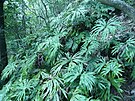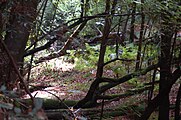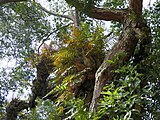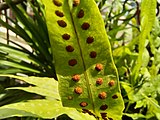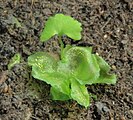Fern
This article needs additional citations for verification. (August 2023) |
| Ferns Temporal range:
| |
|---|---|
| Scientific classification | |
| Kingdom: | Plantae |
| Clade: | Tracheophytes |
| Division: | Polypodiophyta |
| Class: | Polypodiopsida Cronquist, Takht. & W.Zimm. |
| Subclasses[2] | |
| |
| Synonyms | |
| |
The ferns (Polypodiopsida or Polypodiophyta) are a group of vascular plants (plants with xylem and phloem) that reproduce via spores and have neither seeds nor flowers. They differ from mosses by being vascular, i.e., having specialized tissues that conduct water and nutrients and in having life cycles in which the branched sporophyte is the dominant phase.
Ferns have complex
Ferns first appear in the fossil record about 360 million years ago in the late Devonian period, but Polypodiales, the group that makes up 80% of living fern diversity, did not appear and diversify until the Cretaceous, contemporaneous with the rise of flowering plants that came to dominate the world's flora.
Ferns are not of major economic importance, but some are used for food, medicine, as biofertilizer, as ornamental plants, and for remediating contaminated soil. They have been the subject of research for their ability to remove some chemical pollutants from the atmosphere. Some fern species, such as bracken (Pteridium aquilinum) and water fern (Azolla filiculoides), are significant weeds worldwide. Some fern genera, such as Azolla, can fix nitrogen and make a significant input to the nitrogen nutrition of rice paddies. They also play certain roles in folklore.
Description
Sporophyte
Extant ferns are herbaceous
The
In monomorphic ferns, the fertile and sterile leaves look morphologically the same, and both are able to photosynthesize. In hemidimorphic ferns, just a portion of the fertile leaf is different from the sterile leaves. In dimorphic (holomorphic) ferns, the two types of leaves are morphologically distinct.[8] The fertile leaves are much narrower than the sterile leaves, and may have no green tissue at all, as in the Blechnaceae and Lomariopsidaceae.
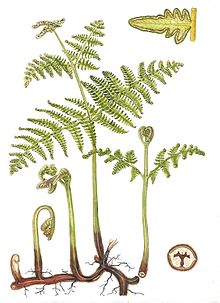
The anatomy of fern leaves can be anywhere from simple to highly divided, or even indeterminate (e.g. Gleicheniaceae, Lygodiaceae). The divided forms are pinnate, where the leaf segments are completely separated from one other, or pinnatifid (partially pinnate), where the leaf segments are still partially connected. When the fronds are branched more than once, it can also be a combination of the pinnatifid are pinnate shapes. If the leaf blades are divided twice, the plant has bipinnate fronds, and tripinnate fronds if they branch three times, and all the way to tetra- and pentapinnate fronds.[9][10] In tree ferns, the main stalk that connects the leaf to the stem (known as the stipe), often has multiple leaflets. The leafy structures that grow from the stipe are known as pinnae and are often again divided into smaller pinnules.[11]
Fern stems are often loosely called
Roots are underground non-photosynthetic structures that take up water and nutrients from soil. They are always fibrous and are structurally very similar to the roots of seed plants.
Gametophyte
As in all
- Prothallus: A green, photosynthetic structure that is one cell thick, usually heart or kidney shaped, 3–10 mm long and 2–8 mm broad. The prothallus produces gametes by means of:
- Antheridia: Small spherical structures that produce flagellate sperm.
- Archegonia: A flask-shaped structure that produces a single egg at the bottom, reached by the sperm by swimming down the neck.
- saltsover the whole structure. Rhizoids anchor the prothallus to the soil.
Taxonomy
Traditionally, three discrete groups have been denominated ferns: two groups of eusporangiate ferns, the families
Molecular phylogenetics
Smith et al. (2006) carried out the first higher-level pteridophyte classification published in the
- Tracheophyta(tracheophytes) - vascular plants
- Euphyllophytina(euphyllophytes)
- Infradivision Moniliformopses(monilophytes)
- Infradivision Spermatophyta- seed plants, ~260,000 species
- Infradivision
- Subdivision Lycopodiophyta(lycophytes) - less than 1% of extant vascular plants
Molecular data, which remain poorly constrained for many parts of the plants' phylogeny, have been supplemented by morphological observations supporting the inclusion of Equisetaceae in the ferns, notably relating to the construction of their sperm and peculiarities of their roots.[18]
The leptosporangiate ferns are sometimes called "true ferns".[19] This group includes most plants familiarly known as ferns. Modern research supports older ideas based on morphology that the Osmundaceae diverged early in the evolutionary history of the leptosporangiate ferns; in certain ways this family is intermediate between the eusporangiate ferns and the leptosporangiate ferns. Rai and Graham (2010) broadly supported the primary groups, but queried their relationships, concluding that "at present perhaps the best that can be said about all relationships among the major lineages of monilophytes in current studies is that we do not understand them very well".[20] Grewe et al. (2013) confirmed the inclusion of horsetails within ferns sensu lato, but also suggested that uncertainties remained in their precise placement.[21] Other classifications have raised Ophioglossales to the rank of a fifth class, separating the whisk ferns and ophioglossoid ferns.[21]
Phylogeny
The ferns are related to other groups as shown in the following cladogram:[17][22][23][2]
Tracheophyta
|
| ||||||||||||||||||
| (vascular plants) |
Nomenclature and subdivision
The classification of Smith et al. in 2006 treated ferns as four classes:[18][24]
- Horsetails) ~ 15 species
- ophioglossoid ferns) ~92 species
- Marattiales~ 150 species
- Polypodiopsida (Filicopsida) 7 orders (leptosporangiate ferns) ~ 9,000 species
In addition they defined 11 orders and 37 families.[18] That system was a consensus of a number of studies, and was further refined.[21][25] The phylogenetic relationships are shown in the following cladogram (to the level of orders).[18][26][21] This division into four major clades was then confirmed using morphology alone.[27]
|
Leptosporangiate Ferns |
Subsequently,
- monotypic (Equisetales, Equisetaceae, Equisetum) horsetails ~ 20 species)
- Ophioglossidae (=Psilotopsida) - 2 monotypic orders ~ 92 species
- Marattiidae (=Marattiopsida) - 1 monotypic order (Marattiales, Marattiaceae, 2 subfamilies) ~ 130 species
- Polypodiidae(=Polypodiopsida) - 7 orders
This was a considerable reduction in the number of families from the 37 in the system of Smith et al., since the approach was more that of
| Christenhusz and Chase 2014[2] | Nitta et al. 2022[29] and Fern Tree of life[30] | ||||||||||||||||||||||||||||||||||||||||||||||||||||||||||||||||||||||||||||||
|---|---|---|---|---|---|---|---|---|---|---|---|---|---|---|---|---|---|---|---|---|---|---|---|---|---|---|---|---|---|---|---|---|---|---|---|---|---|---|---|---|---|---|---|---|---|---|---|---|---|---|---|---|---|---|---|---|---|---|---|---|---|---|---|---|---|---|---|---|---|---|---|---|---|---|---|---|---|---|---|
|
|
In the Pteridophyte Phylogeny Group classification of 2016 (PPG I), the Polypodiopsida consist of four subclasses, 11 orders, 48 families, 319 genera, and an estimated 10,578 species.
| Smith et al. (2006)[18] | Chase & Reveal (2009)[23] | Christenhusz et al. (2011)[28] | Christenhusz & Chase (2014, 2018)[17][33] | PPG I (2016)[2] |
|---|---|---|---|---|
| ferns (no rank) |
monilophytes (no rank) |
ferns (monilophytes) (no rank) |
ferns (Polypodiophyta) (no rank) |
Class Polypodiopsida |
| Class Equisetopsida | Subclass Equisetidae | Subclass Equisetidae | Subclass Equisetidae | Subclass Equisetidae |
| Class Psilotopsida | Subclass Ophioglossidae Subclass Psilotidae |
Subclass Ophioglossidae | Subclass Ophioglossidae | Subclass Ophioglossidae |
| Class Marattiopsida | Subclass Marattiidae | Subclass Marattiidae | Subclass Marattiidae | Subclass Marattiidae
|
| Class Polypodiopsida | Subclass Polypodiidae | Subclass Polypodiidae | Subclass Polypodiidae | Subclass Polypodiidae
|
Evolution and biogeography
Fern-like taxa ( Ferns evolved to cope with low-light conditions present under the canopy of angiosperms.
Remarkably, the photoreceptor neochrome in the two orders Cyatheales and Polypodiales, integral to their adaptation to low-light conditions, was obtained via horizontal gene transfer from hornworts, a bryophyte lineage.[37]
Due to the very large genome seen in most ferns, it was suspected they might have gone through whole genome duplications, but DNA sequencing has shown that their genome size is caused by the accumulation of mobile DNA like transposons and other genetic elements that infect genomes and get copied over and over again.[38]
Distribution and habitat
Ferns are widespread in their distribution, with the greatest richness in the tropics and least in arctic areas. The greatest diversity occurs in tropical rainforests.[39] New Zealand, for which the fern is a symbol, has about 230 species, distributed throughout the country.[40] It is a common plant in European forests.
Ecology
Fern species live in a wide variety of habitats, from remote mountain elevations, to dry desert rock faces, bodies of water or open fields. Ferns in general may be thought of as largely being specialists in marginal habitats, often succeeding in places where various environmental factors limit the success of flowering plants. Some ferns are among the world's most serious weed species, including the bracken fern growing in the Scottish highlands, or the mosquito fern (Azolla) growing in tropical lakes, both species forming large aggressively spreading colonies. There are four particular types of habitats that ferns are found in: moist, shady forests; crevices in rock faces, especially when sheltered from the full sun; acid wetlands including bogs and swamps; and tropical trees, where many species are epiphytes (something like a quarter to a third of all fern species).[41]
Especially the epiphytic ferns have turned out to be hosts of a huge diversity of invertebrates. It is assumed that bird's-nest ferns alone contain up to half the invertebrate biomass within a hectare of rainforest canopy.[42]
Many ferns depend on associations with
The spores are rich in
-
In undergrowth below coast redwoods, California
-
Fern bed under a forest canopy, Virginia
-
On a wall
-
Epiphytic ferns in India
Life cycle
Ferns are
The life cycle of a typical fern proceeds as follows:
- A diploid sporophyte phase produces haploid spores by meiosis (a process of cell division which reduces the number of chromosomes by a half).
- A spore grows into a free-living haploid gametophyte by mitosis (a process of cell division which maintains the number of chromosomes). The gametophyte typically consists of a photosynthetic prothallus.
- The gametophyte produces eggson the same prothallus) by mitosis.
- A mobile, flagellate sperm fertilizes an egg that remains attached to the prothallus.
- The fertilized egg is now a diploid zygote and grows by mitosis into a diploid sporophyte (the typical fern plant).
Sometimes a gametophyte can give rise to sporophyte traits like roots or sporangia without the rest of the sporophyte.[44]
-
monarch fern, with sporangium
-
Gametophyte (thallus) and sporophyte (ascendant frond) of Onoclea sensibilis
Uses
Ferns are not as important economically as seed plants, but have considerable importance in some societies. Some ferns are used for food, including the fiddleheads of Pteridium aquilinum (
Ferns of the genus Azolla, commonly known as water fern or mosquito ferns are very small, floating plants that do not resemble ferns. The mosquito ferns are used as a biological fertilizer in the rice paddies of southeast Asia, taking advantage of their ability to fix nitrogen from the air into compounds that can then be used by other plants.
Ferns have proved resistant to phytophagous insects. The gene that express the protein Tma12 in an edible fern, Tectaria macrodonta, has been transferred to cotton plants, which became resistant to whitefly infestations.[51]
Many ferns are grown in
Several ferns, such as bracken
Culture

Pteridology
The study of ferns and other pteridophytes is called pteridology. A pteridologist is a specialist in the study of pteridophytes in a broader sense that includes the more distantly related lycophytes.
Pteridomania
Other applications

The Barnsley fern is a fractal named after the British mathematician Michael Barnsley who first described it in his book Fractals Everywhere. A self-similar structure is described by a mathematical function, applied repeatedly at different scales to create a frond pattern.[59]
The dried form of ferns was used in other arts, such as a stencil or directly inked for use in a design. The botanical work, The Ferns of Great Britain and Ireland, is a notable example of this type of nature printing. The process, patented by the artist and publisher Henry Bradbury, impressed a specimen on to a soft lead plate. The first publication to demonstrate this was Alois Auer's The Discovery of the Nature Printing-Process.
Fern bars were popular in America in the 1970s and 80s.
Folklore
Ferns figure in folklore, for example in legends about mythical flowers or seeds.
New Zealand
Ferns are the national emblem of New Zealand and feature on its passport and in the design of its national airline,
Organisms confused with ferns
Misnomers
Several non-fern plants (and even animals) are called ferns and are sometimes confused with ferns. These include:
- Asparagus fern—This may apply to one of several species of the monocot genus Asparagus, which are flowering plants.
- Sweetfern—A flowering shrub of the genus Comptonia.
- Air fern—A group of animals called hydrozoans that are distantly related to jellyfish and corals. They are harvested, dried, dyed green, and then sold as a plant that can live on air. While it may look like a fern, it is merely the skeleton of this colonial animal.
- Fern bush—Chamaebatiaria millefolium—a rose family shrub with fern-like leaves.
- Fern tree—ornamental tree of the order Lamiales.
- Fern leaf tree—ornamental tree of the order Sapindales.
Fern-like flowering plants
Some
See also
Notes
- ^ President, International Association of Pteridologists
References
- ^ a b Stein et al 2007.
- ^ a b c d e Pteridophyte Phylogeny Group 2016.
- ISBN 978-1-4496-4720-9.
- ^ OCLC 621340.
- ISBN 978-1-4419-7162-3.
- ISBN 978-1-57954-966-4.
- ^ McCausland 2019.
- ^ Understanding the contribution of LFY and PEBP flowering genes to fern leaf dimorphism - Botany 2019
- ^ Fern Structure - Forest Service
- ^ Fern Structure - Forest Service
- ^ "Fern Fronds". Basic Biology. Archived from the original on 19 April 2015. Retrieved 6 December 2014.
- ISBN 0881926302.
- ^ Underwood 1903.
- ^ Linnaeus 1753.
- ^ a b Schuettpelz et al 2018.
- ^ Swartz 1806.
- ^ a b c d Christenhusz & Chase 2014.
- ^ a b c d e f Smith et al.2006.
- ISBN 978-0-521-70772-5.
- PMID 21616899., p. 1450
- ^ PMID 23311954.
- ^ Cantino et al 2007.
- ^ a b c Chase & Reveal 2009.
- ^ Schuettpelz 2007, Table I.
- PMID 20969798.
- PMID 22028918.
- ^ Schneider et al 2009.
- ^ a b Christenhusz et al 2011.
- PMID 36092417.
- ^ "Tree viewer: interactive visualization of FTOL". FTOL v1.3.0. 2022. Retrieved 12 December 2022.
- ^ Christenhusz & Byng 2016.
- ^ Christenhusz & Chase 2018.
- ^ Christenhusz et al 2018.
- ^ UCMP 2019.
- ^ Berry 2009.
- ^ Bomfleur et al 2014.
- PMID 24733898.
- ^ Genes for seeds arose early in plant evolution, ferns reveal
- ^ EB 2019.
- ^ SLH 2018.
- ^ Schuettpelz 2007, Part I.
- ^ "Ferns Brimming With Life". Science | AAAS. 2 June 2004.
- ^ Walker, Matt (19 February 2010). "A mouse that eats ferns like a dinosaur". BBC Earth News. Retrieved 20 February 2010.
- ^ The Ferns (Filicales): Volume 1, Analytical Examination of the Criteria of Comparison: Treated Comparatively with a View to their Natural Classification
- ^ Indigenous Fermented Foods of Southeast Asia. 2015.
- ^ Van Gilder Cooke, Sonia (23 October 2010). "Stone Age humans liked their burgers in a bun". New Scientist, p. 18.
- PNAS.
- ^ Pelton, Robert (2011). The Official Pocket Edible Plant Survival Manual. Freedom and Liberty Foundation Press. p. 25. BNID 2940013382145.
- ISBN 978-1-60469-189-4.
- ^ "Dol Sot Bibimbap". Archived from the original on 11 November 2011. Retrieved 19 December 2011.
- S2CID 384923.
- ^ "Ferns: A Classic Shade Garden Plant". extension.sdstate.edu. Retrieved 30 May 2023.
- ^ "Datasheet: Pteridium aquilinum (bracken)". CAB International. 2018. Retrieved 11 February 2019.
- ^ "Datasheet: Azolla filiculoides (water fern)". CAB International. 2018. Retrieved 11 February 2019.
- ^ "| Center for Aquatic and Invasive Plants | University of Florida, IFAS". plants.ifas.ufl.edu. Retrieved 30 May 2023.
- ISBN 0-88192-667-1.
- ^ "Fossils, Kentucky Geological Survey, University of Kentucky". www.uky.edu. Retrieved 30 May 2023.
- ^ Boyd, Peter D. A. (2 January 2002). "Pteridomania - the Victorian passion for ferns". Antique Collecting. Revised: web version. 28 (6): 9–12. Retrieved 2 October 2007.
- ^ ISBN 0-12-079062-9
- ^ May 1978.
- ^ "Traditional Finnish Midsummer celebration". Saunalahti.fi. Retrieved 7 September 2013.
- ^ Cunningham, Scott (1999). Cunningham's Encyclopedia of Magical Herbs. Llewellyn. p. 102.
Bibliography
Books
- ISBN 978-0-9929993-6-0.
- Linnaeus, Carl (1753). "Cryptogamia: Filices Musci". Species Plantarum: exhibentes plantas rite cognitas, ad genera relatas, cum differentiis specificis, nominibus trivialibus, synonymis selectis, locis natalibus, secundum systema sexuale digestas. Vol. 1. Stockholm: Impensis Laurentii Salvii. pp. 1061–1100, 1100–1130., see also Species Plantarum
- Lord, Thomas R. (2006). Ferns and Fern Allies of Pennsylvania. Indiana, PA: Pinelands Press. Ferns and Fern Allies of Pennsylvania – Thomas Reeves Lord
- Moran, Robbin C. (2004). A Natural History of Ferns. Portland, OR: Timber Press. ISBN 0-88192-667-1.
- Ranker, Tom A.; Haufler, Christopher H. (2008). Biology and Evolution of Ferns and Lycophytes. ISBN 978-0-521-87411-3.
- Kiliae: Impensis Bibliopolii novi academici.
Journal articles
- Berry, Chris (2009). "The Middle Devonian plant collections of Francois Stockmans reconsidered". Geologica Belgica. 12 (1–2): 25–30.
- Bomfleur, B.; McLoughlin, S.; Vajda, V. (20 March 2014). "Fossilized Nuclei and Chromosomes Reveal 180 Million Years of Genomic Stasis in Royal Ferns". S2CID 38248823.
- Cantino, Philip D.; Doyle, James A.; Graham, Sean W.; JSTOR 25065865.
- .
- .
- .
- PMID 24532607.
- doi:10.12705/673.2.
- May, Lenore Wile (1978). "The economic uses and associated folklore of ferns and fern allies". S2CID 42101599.
- Melan, M. A.; Whittier, D. P. (1990). "Effects of Inorganic Nitrogen Sources on Spore Germination and Gametophyte Growth in Botrychium Dissectum". Plant, Cell and Environment. 13 (5): 477–82. .
- Pryer, Kathleen M.; Schneider, Harald; Smith, Alan R.; Cranfill, Raymond; Wolf, Paul G.; Hunt, Jeffrey S.; Sipes, Sedonia D. (2001). "Horsetails and ferns are a monophyletic group and the closest living relatives to seed plants". Nature. 409 (6820): 618–622. S2CID 4367248.
- Pryer, Kathleen M.; Schuettpelz, Eric; Wolf, Paul G.; Schneider, Harald; Smith, Alan R.; Cranfill, Raymond (2004). "Phylogeny and evolution of ferns (monilophytes) with a focus on the early leptosporangiate divergences". American Journal of Botany. 91 (10): 1582–1598. PMID 21652310.
- Pteridophyte Phylogeny Group (November 2016). "A community-derived classification for extant lycophytes and ferns". Journal of Systematics and Evolution. 54 (6): 563–603. S2CID 39980610.
- Schneider, Harald; Smith, Alan R.; Pryer, Kathleen M. (1 July 2009). "Is Morphology Really at Odds with Molecules in Estimating Fern Phylogeny?". S2CID 85855934.
- Schuettpelz, Eric (2007). "Table 1". The evolution and diversification of epiphytic ferns (PDF) (PhD thesis). Duke University. Archived from the original(PDF) on 20 June 2010. Retrieved 11 December 2009.
- Schuettpelz, Eric; Rouhan, Germinal; Pryer, Kathleen M.; Rothfels, Carl J.; Prado, Jefferson; Sundue, Michael A.; Windham, Michael D.; Moran, Robbin C.; Smith, Alan R. (1 June 2018). "Are there too many fern genera?". doi:10.12705/673.1.
- Smith, Alan R.; Kathleen M. Pryer; Eric Schuettpelz; Petra Korall; Harald Schneider; Paul G. Wolf (2006). "A classification for extant ferns" (PDF). JSTOR 25065646.
- Stein, W. E.; Mannolini, F.; Hernick, L. V.; Landling, E.; Berry, C. M. (2007). "Giant cladoxylopsid trees resolve the enigma of the Earth's earliest forest stumps at Gilboa". S2CID 2575688.
- Radoslaw Janusz Walkowiak (2017). "Classification of Pteridophytes - Short classification of the ferns" (PDF). IEA Paper. .
- Underwood, L. M. (1903). "The early writers on ferns and their collections.— I. Linnaeus, 1707-1778". JSTOR 40594126.
Websites
- McCausland, Jim (22 February 2019). "Rediscover ferns". Garden plants. Sunset Magazine. Archived from the original on 30 October 2021. Retrieved 22 November 2019.
- "Pteridopsida: Fossil Record". Plants: Pteridopsida. University of California Museum of Paleontology. Retrieved 23 November 2019.
- "Classifying and identifying ferns". Science Learning Hub. The University of Waikato. 3 September 2018. Retrieved 24 November 2019.
- Mickel, John T.; Wagner, Warren H.; Gifford, Ernest M.; et al. (4 February 2019). "Fern". Encyclopædia Britannica. Retrieved 24 November 2019.
- Hassler, Michael; Schmitt, Bernd (2 November 2019). "Checklist of Ferns and Lycophytes of the World". World Ferns. Botanical Garden of the Karlsruhe Institute of Technology. Archived from the originalon 2 September 2017. Retrieved 25 November 2019.
- Pryer, Kathleen M.; Smith, Alan R.; Rothfels, Carl (2009). "Polypodiopsida". Tree of Life.
- A classification of the ferns and their allies.
- A fern book bibliography.
- Register of fossil Pteridophyta
- Watson, L. and M. J. Dallwitz (2004 onwards). The Ferns (Filicopsida) of the British Isles. Archived 3 March 2016 at the Wayback Machine
- Ferns and Pteridomania in Victorian Scotland.
- Non-seed plant images at bioimages.vanderbilt.edu
- American Fern Society
- British Pteridological Society
External links
 Data related to Pteridophyta at Wikispecies
Data related to Pteridophyta at Wikispecies Media related to Polypodiopsida at Wikimedia Commons
Media related to Polypodiopsida at Wikimedia Commons

